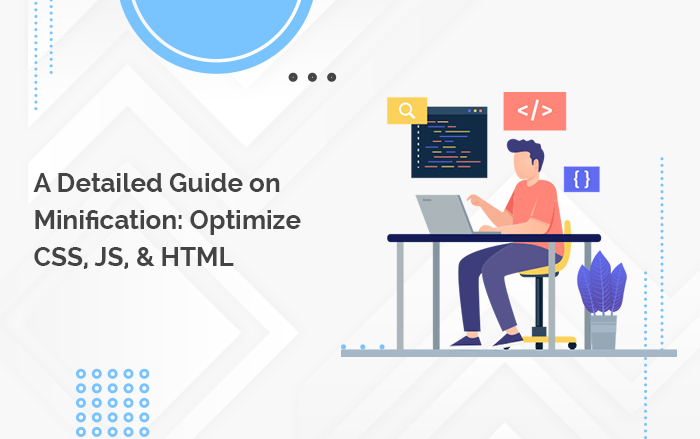Heavy scripts and unnecessary code can slow down your website. Using Minify Resources techniques such as your CSS, JavaScript & HTML optimization practice can help you boost your website speed and performance.
In 2022, As far as we know the significance of speeding up WordPress or other CMSs, there are lots of ways that caught major priority. However, when talking about website optimization, minification is considered one of the most under-rated and misunderstood concepts.
This concept might look simple to understand but requires a deep understanding of the technical knowledge and what it entails. Here in this blog post, we are going to cover everything you need to know about what is minification and why it is needed.
Minification can be defined as the process of simplifying characters from the code without changing their function. It is one of the most effective web development processes to have fast loading web page speed. Read further on to get detailed insights about what minification really is and how it works.
What is Minification in detail?
Minification can be defined as the process of reducing all unused code and characters from the original code of the page without letting the functionality be altered or sacrificed. It works in such a way that it eliminates a code file containing all redundant or unnecessary data that are unimportant for the file to be carried out.
Unnecessary code happens because of the use of characters like comments, block delimiters, line breaks, and white space characters. In order to make code lighter, you can concatenate those unused files and save memory.
Minification is carried out once coding has been completed, before final deployment. It is majorly about editing your code to make it quickly accessible for webpage visitors. As a result, minifying CSS & JavaScript allows your users to get fast access to the minified version of the webpage instead of rendering its full version.
If seeing a bigger picture, increases the response times and reduces the loading time. Whether you are having a blog, or high traffic website, minifying will be beneficial. Minification can be used with different languages like; HTML, CSS, and even JS.
How Does Minification Works?

Minification is a well-known development practice that works in a way that allows developers to rework the general code file and make reductions in the size of the file. Minify Resources helps in extending the script, style, and other components used by the web browser to power the website.
Minification makes code lighter to render the website, making your website assets and resources quicker to distribute to the requested users. But what the minification is exactly about is what you need to understand with this how-to guide.
The browser reads all the extra characters that the web page developer creates while writing code. As a result, the webpage becomes heavier and larger to load. The optimization developer Minify Resources or eliminates this extra code present in the form of whitespace, comments, and line breaks, that were previously action as redundant space in the file.
These excesses of code don’t require the computers to render the page. When a code goes from the Minify Resources process, it goes a long to reduce the file size by the given process:
- A web programmer makes a JavaScript or CSS file of a web page which will be further formatted by the programmer or optimization developer to make it minified.
- The optimization developer will use minification to convert the file into its light and short version. The minification process helps in making creating an augmented or compressed format of a web page. This compact code of the file is now difficult to understand. The popular ways to minify your file are to reduce every variable name, eliminate all the white space within a file, converting longer functions into short functions.
- Minified version of the webpage used by the web server and used when a response is required by the user to render it. This minified page uses less bandwidth without sacrificing the original function of the files.
Benefits of Minification in terms of Website Optimization Importance
As you’ve gone through the working of minification, we can expect it as one of the methods for site optimization. Here are some huge importance or benefits of minification:
- Minify Resources improves loading time: Minification helps in reducing the loading time when someone visits the page. A minified version of a web page responds faster than a webpage that hasn’t been minified. It is proved that minification increases the time a page needs to load by 60% or more.
- You don’t need to download unnecessary data: After removing the unwanted codes like; comments, line breaks, from the code file. Minification can help you reduce the file size by keeping important code from the general file and removing unnecessary code. Accordingly, this saves your users time by not allowing them to download unnecessary data. Now the amount of data used by users when getting a request is not much compared to that of an un-minified page
- Provide Better Users experience: As we now know minifying a website value loading time. Thus, it also makes your user’s interaction better when it comes to providing an overall user experience better. Moreover, you’ll see a huge gain in the performance of the website when your users find your web page responsive and fast to load.
- Higher SERP Ranking: SEO performance or SERP ranking is harder to gain only with a few optimization techniques. The bigger picture is you’ll need to take advantage of best practices of optimization. As far as minification is concerned, there is a huge opportunity for you to enjoy higher ranking, user-friendliness, and eventually, more conversions.
The Best Minification Method & Tool Available for you

There are lots of plugins & online tools for you to do minification but they often add their own CSS and unwanted scripts. As a result, your website gets affected in terms of speed and performance. However, as a leader in the WordPress and other CMS optimization world, we have created our very own top-quality optimization plugin for WordPress users i.e. W3speedster. It can help you minify the code with just one click.
It can help you perfectly optimize CSS, and JS via minification. When minifying your images or other forms of content, it is the best option available to you undoubtedly. You don’t even need to use additional compression methods or plugins, W3speedster is a one-stop solution with a wide array of functionalities and features. There will be a guaranteed improvement in the speed, performance, and reduction in the bandwidth of your website after you’ll use the plugin on your WordPress.
FAQs
What is the Difference between Concatenation and Minification?
Where Minification is the process of minifying or removing unused or unnecessary files or code, concatenation is the process of creating one large file by joining all small files together. However, both of the techniques are helpful and leave the same results as expected i.e. page optimization.
Doing concatenation can significantly reduce the number of files that need to be downloaded, thereby, greatly increasing the speed.
Why don’t developers write minified code?
JavaScript code written by programmers uses whitespace, formatting, and comments to let other programmers understand and debug the code. While minification results in compressed code to achieve higher web performance, it is also harder to understand minified code.
What are the disadvantages of minification?
Minification makes the scripts straightforward and breaks complicated code because of site variables like themes, plugins, and servers. Moreover, it must be done in conjunction with other performance optimization tricks and techniques. Minification doesn’t have significant gains and can also end up giving many errors that are hard to debug.



